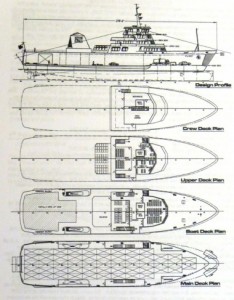
New Lynn Canal shuttle ferries will be 280 feet long, seat about 300 passengers and operate no more than 12 hours a day.
Part, but not all, of the car deck may be open. And the ships will have no staterooms or crew quarters.
That’s according to a draft design-concept report prepared for the Alaska Marine Highway System by Anchorage-based Coastwise Corporation.
Officials say it’s one of several steps in the design process for what’s being called the Day Boat-Alaska Class Ferry.The shuttle plan replaces an earlier Alaska Class design that called for a larger vessel that could sail longer routes.
Deputy Transportation Commissioner Reuben Yost says amenities will be limited, including food service.
“What we envision at this point of time is vending machines. So it would be similar to what we have on the fast ferries, in terms of amenities. So there won’t be a cafeteria, there won’t be cooked for but there will be food in machines and drinks in machines most likely,” Yost says.
Hulls and decks will be configured so vehicles can drive in one end and out the other, for quicker loading and unloading.
Yost says the ships could carry 53 large vehicles, but not all would be under cover.
“Essentially the vehicle space for the last 15 vehicles, if the car deck was full, would be in an area that we’re saying potentially could have an open roof,” he says.
Yost says high walls and other design elements will protect against ocean spray. He also says the vehicle deck is usually not full in winter months when wind and waves are at their worst.
Marine Highway General Manager John Falvey says the ships will be designed for Lynn Canal’s harsh conditions. For example, they’ll lack sponsons, which project from the side of the hull.
“It will not have the sponsons forward, which eliminates a lot of the slamming and potentially a very flared … bow which will deflect the spray. We feel that a vessel of these characteristics will have very good sea-keeping ability,” Falvey says.
They would be built to sail at an average speed of 15-and-a-half knots. That’s about the same as other ships in the fleet, except the fast ferries.
The design document estimates the final design could be completed by next November. And officials hope to keep costs within the $117 million put aside by the state.
Falvey says plans are to build two identical vessels.
“The shipyard is, in essence, lofted up and tooled up as far as their particular class of vessel that they’re building. You can throw a lessons learned and experience factor into the second vessel. There are actually many savings we will be able to see on the second vessel if we are able to sign a two-ship contract with the shipyard,” he says.
The draft plan will be presented to the Marine Transportation Advisory Board and the House and Senate Transportation Committees this week.
Opportunities for public comment will come later in the process.
Ed Schoenfeld is Regional News Director for CoastAlaska, a consortium of public radio stations in Ketchikan, Juneau, Sitka, Petersburg and Wrangell.
He primarily covers Southeast Alaska regional topics, including the state ferry system, transboundary mining, the Tongass National Forest and Native corporations and issues.
He has also worked as a manager, editor and reporter for the Juneau Empire newspaper and Juneau public radio station KTOO. He’s also reported for commercial station KINY in Juneau and public stations KPFA in Berkley, WYSO in Yellow Springs, Ohio, and WUHY in Philadelphia. He’s lived in Alaska since 1979 and is a contributor to Alaska Public Radio Network newscasts, the Northwest (Public Radio) News Network and National Native News. He is a board member of the Alaska Press Club. Originally from Cleveland, Ohio, he lives in Douglas.




